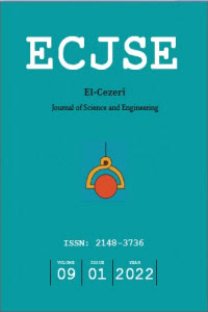Classification of Malware in HTTPs Traffic Using Machine Learning Approach
Network traffic, Classification, HTTPs, Malware, Wireshark, Machine learning
Classification of Malware in HTTPs Traffic Using Machine Learning Approach
Classification, HTTPs, Malware, Wireshark, Machine learning,
___
- [1]. Wang, W., Zhu, M.,Zeng,X., et.al., “Malware traffic classification using convolutional neural network for representation learning” in international conference on information networking (ICOIN), pp 712-717, IEEE, 2017.
- [2]. C. McCarthy et al., “An investigation on identifying SSL traffic,” in Computational Intelligence for Security and Defense Applications (CISDA), IEEE Symposium on. IEEE, pp. 115–122, 2011.
- [3]. Husák, M., Čermák, M., Jirsík, T. and Čeleda, P., “HTTPS traffic analysis and client identification using passive SSL/TLS fingerprinting" EURASIP Journal on Information Security, pp.1-14, 2016.
- [4]. Becker, Jamin. “A Free, Online PCAP Analysis Engine.” Available at: www.packettotal.com/.
- [5]. “Wireshark.” Wireshark • Go Deep., Available at: www.wireshark.org/.
- [6]. “CICFlowMeter.” NetFlowMeter, Available at: www.netflowmeter.ca/.
- [7]. What is a computer virus or a computer worm? Available at: https://usa.kaspersky.com/resource-center/threats/computer-viruses-vs-worms
- [8]. Marczak, Bill & Scott-Railton, John & Mckune, Sarah & Deibert, Ron & Abdulrazzak, Bahr "HIDE AND SEEK Tracking NSO Group’s Pegasus Spyware to Operations in 45 Countries" 2018.
- [9]. What is a backdoor? Available at: https://www.wired.com/2014/12/hacker-lexicon-backdoor/.
- [10]. Kim, S., Park, J., Lee, K., You, I. and Yim, K., "A Brief Survey on Rootkit Techniques in Malicious Codes" J. Internet Serv. Inf. Secur.,vol no 2(3/4), pp.134-147, 2012.
- [11]. Malode, S.K. and Adware, R.H., "Regenerative braking system in electric vehicles" International Research Journal of Engineering and Technology (IRJET), no 3(3), pp.394-400, 2016.
- [12]. Mohurle, S. and Patil, M., "A brief study of wanna cry threat: Ransomware attack " International Journal of Advanced Research in Computer Science, Vol.8, No.5, pp.1938-1940, 2017.
- [13]. Rezaei, S. and Liu, X., "Deep learning for encrypted traffic classification: An overview". IEEE communications magazine, Vol.57 No.5, pp.76-81, 2019.
- [14]. Valenti, S., Rossi, D., Dainotti, A., Pescapè, A., Finamore, A., & Mellia, M. "Reviewing traffic classification. In Data Traffic Monitoring and Analysis” Springer, Berlin, Heidelberg, pp.123-147, 2013.
- [15]. Zhao, J., Jing, X., Yan, Z. and Pedrycz, W., "Network traffic classification for data fusion: A survey" Information Fusion, 72, pp.22-47, 2021.
- [16]. T. Karagiannis, K. Papagiannaki, N. Taft, and M. Faloutsos, “Profiling the end host,” in Passive and Active Network Measurement, S. Uhlig, K. Papagiannaki, and O. Bonaventure, Eds., vol. 4427 of Lecture Notes in Computer Science, pp. 186–196, Springer, Heidelberg, Germany, 2007.
- [17]. K. Xu, Z.-L. Zhang, and S. Bhattacharyya 2005 “Profiling internet backbone traffic: behavior models and applications,” in Proceedings of the Conference on Applications, Technologies, Architectures, and Protocols for Computer Communications (SIGCOMM '05), vol. 35, no. 4, pp. 169–180, ACM.
- [18]. M. Iliofotou, P. Pappu, M. Faloutsos, M. Mitzenmacher, S. Singh, and G. Varghese, 2007 “Network monitoring using traffic dispersion graphs (TDGs),” in Proceedings of the 7th ACM SIGCOMM Internet Measurement Conference (IMC '07), pp. 315–320, San Diego, Calif, USA, October.
- [19]. P. Bermolen, M. Mellia, M. Meo, D. Rossi, and S. Valenti, 2011 “Abacus: accurate behavioral classification of P2P-TV traffic,” Computer Networks, vol. 55, no. 6, pp. 1394–1411.
- [20]. Bakhshi, T., & Ghita, B. 2016 "On internet traffic classification: A two-phased machine learning approach" Journal of Computer Networks and Communications.
- [21]. Zhang, X. D. 2020 “Machine learning. In A Matrix Algebra Approach to Artificial Intelligence" (pp. 223-440). Springer, Singapore.
- [22]. Zheng, R., Liu, J., Niu, W., Liu, L., Li, K., & Liao, S. "Preprocessing Method for Encrypted Traffic Based on Semi supervised Clustering. Security and Communication Networks”, 2020.
- [23]. J. Lokoc, J. Kohout, P. Cech, T. Skopal, and T. Pevny, “k NN Classification of Malware in HTTPS Traffic Using the Metric Space Approach” LNCS, vol. 9650, Springer pp.131–145,2016.
- [24]. Paul Prase, Lukas Machlica, “Malware Detection by Analyzing Encrypted Network Traffic with Neural Networks” LNCS, vol.10535, Springer pp. 73-88, 2017.
- [25]. Soutner, D. and Müller, L. "Application of LSTM neural networks in language modelling" In International Conference on Text, Speech and Dialogue (pp. 105-112). Springer, Berlin, Heidelberg, 2013.
- [26]. Paul Calderon, 2018 "Malware Detection Based on HTTPS Characteristics via Machine Learning" In Proceedings of the 4th International Conference on Information Systems Security and Privacy pp. 410-417.
- [27]. “Welcome!” Openrefine.github.com, Available at: openrefine.org/.
- [28]. Waikato Environment for Knowledge Analysis (WEKA), Available at: https://www.cs.waikto.ac.nz/ml.
- [29]. N.Moustafa, J. Hu, and J. Slay, 2019 “A holistic review of Network Anomaly Detection Systems: A Comprehensive survey,” J. Netw. Comput. Appl., vol. 128, no. December, pp. 33-55, doi:10.1016/j.jnca.2018.12.006.
- ISSN: 2148-3736
- Yayın Aralığı: Yılda 3 Sayı
- Başlangıç: 2013
- Yayıncı: Tüm Bilim İnsanları ve Akademisyenler Derneği
AISI 4140 ÇELİĞİNİN FREZLEMESİNİN TAGUCHİ-DEAR YÖNTEMİYLE OPTİMİZAYONU
Rebaz OMER, Lana AHMED, Jwameer HAMA, Pelin KOPARIR
Ayoub KHALDAN, Soukaina BOUAMRANE, Reda EL-MERNİSSİ, Hamid MAGHAT, Mohammed Aziz AJANA, Abdelouahid SBAİ, Mohammed BOUACHRINE, Tahar LAKHLIFI
Yakıt tüketim tasarrufu için gerçek zamanlı kazan kontrol algoritması geliştirme
İbrahim ÇETİNER, Halit ÇETİNER
Classification of Malware in HTTPs Traffic Using Machine Learning Approach
Hidrojen Enerjisinin Bibliyometrik Analizi ve Değerlendirilmesi: En Çok Atıf Alan İlk 100 Çalışma
Z-Kaynak İnverter Kontrol Tekniklerinin Performans Analizi
Mustafa Sacid ENDİZ, Ramazan AKKAYA
Öğrencilerin Akademik Performanslarının Tahmin Edilmesi için AutoML Tekniğinin Uygulanması
